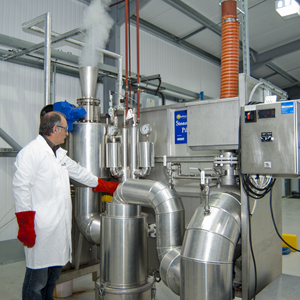UK researchers aim to convert oilseed straw into biofuels

Institute of Food Research
May 30, 2014
BY Institute of Food Research
The bright yellow fields of oilseed rape are a familiar sight at this time of year, but for scientists what lies beneath is just as exciting.
Researchers at the Institute of Food Research are looking at how to turn straw from oilseed rape into biofuel. Preliminary findings are pointing at ways the process could be made more efficient, as well as how the straw itself could be improved.
Straw from crops such as wheat, barley, oats and oilseed rape is seen as a potential source of biomass for second generation biofuel production. Currently the U.K. produces around 12 million metric tons of straw. Although much is used for animal bedding, mushroom compost and energy generation, there still exists a vast surplus.
Straw contains a mix of sugars that could be used as a source of biofuels that do not compete with food production but instead represent a sustainable way of utilizing waste. However, the sugars are in a form that makes them inaccessible to the enzymes that release them for conversion into biofuels, so pre-treatments are needed. The pre-treatments make the complex carbohydrates more accessible to enzymes that convert them to glucose, in a process called saccharification. This is then fermented by yeast into ethanol.
Advertisement
Using the facilities at the Biorefinery Centre on the Norwich Research Park, Professor Keith Waldron and his team have been looking at the steps needed to unlock the sugars tied up in the tough straw structure. In particular, they have looked at the pre-treatment stage, focusing on steam explosion, which involves ‘pressure-cooking’ the biomass, to drive a number of chemical reactions. A rapid pressure-release then causes the material to be ripped open, to further improve accessibility.
They varied the temperature and duration of steam explosion and then used a variety of physical and biochemical techniques to characterise what effects varying the pre-treatments had on the different types of sugars before and after saccharification.
The amount of cellulose converted to glucose increased with the severity of the pretreatment. Saccharification efficiency is also associated with the loss of specific sugars, and subsequent formation of sugar breakdown products.
Advertisement
In a further study funded by the BBSRC / EPSRC Integrated Biorefining Research and Technology Club, the scientists discovered the key factors that determine the efficiency of saccharification. One particular compound, uronic acid, limited the rate at which enzymes worked. The final sugar yield was closely related to the removal of xylan, a common component of plant cell walls. The abundance of lignin, a ‘woody’ cell wall component, was positively related to the amount of available sugars.
These findings will help improve the efficiency by which straw can be converted to biofuels. For example, adding enzymes that more effectively remove xylan should improve yield. Controlling the level of lignin in the material should also help.
It may even be possible to improve the straw itself, for example to reduce the uronic acid content in the biomass, as suggested by these findings. In the main, oilseed rape has been bred to improve oilseed yield and disease resistance, without paying much attention to the straw. The IFR is working with colleagues at the University of York and the John Innes Centre to see whether there are ways of breeding more “biofuel-ready” varieties of oilseed rape, with the same yields of oilseed but with more amenable straw. In addition, a full understanding of the polysaccharides and other compounds made available during pretreatment may mean other valuable co-products, like platform chemicals, may be viably produced from the surplus straw.
Related Stories
The USDA significantly increased its estimate for 2025-’26 soybean oil use in biofuel production in its latest World Agricultural Supply and Demand Estimates report, released July 11. The outlook for soybean production was revised down.
U.S. fuel ethanol capacity fell slightly in April, while biodiesel and renewable diesel capacity held steady, according to data released by the U.S. EIA on June 30. Feedstock consumption was down when compared to the previous month.
The U.S. EPA on July 8 hosted virtual public hearing to gather input on the agency’s recently released proposed rule to set 2026 and 2027 RFS RVOs. Members of the biofuel industry were among those to offer testimony during the event.
The USDA’s Risk Management Agency is implementing multiple changes to the Camelina pilot insurance program for the 2026 and succeeding crop years. The changes will expand coverage options and provide greater flexibility for producers.
The USDA’s National Agricultural Statistics Service on June 30 released its annual Acreage report, estimating that 83.4 million acres of soybeans have been planted in the U.S. this year, down 4% when compared to 2024.
Upcoming Events










